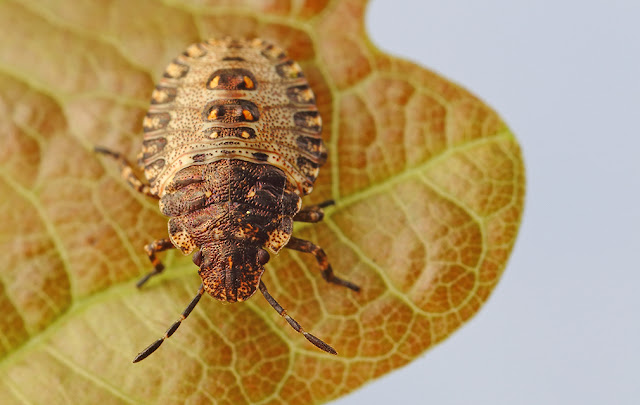Here we go again then. Time for another update. The whole point of these updates, well the whole point of my blog actually, is to try to imbue you with some of the enthusiasm that I have for the natural world and bugs in particular.
Since I first started blogging, almost a decade ago now, it has become increasingly 'sexy' to talk about the environment and the role insects play within our world. Perhaps at long last the people wielding the power will do the right thing. I actually heard a farmer saying on TV the other day that they had "ignored nature until now, but could do so no longer". There's progress!
Meantime, I shall continue to do my little bit in any way I can...
In my last update I talked about camouflage. Here's another tiny bug that uses this in what seems like quite an extreme manner. For starters, this Psocid nymph in my photo is only 2mm long max. Does something so small even require camouflage?
I guess the answer must be yes, or why bother. Here's another photo that shows you what I actually saw before closing in for a macro shot...
Not exactly standing out like a porcupine at a nudist colony is it! And yet it does seem that bugs of this species all do it. I think it might just be confined to the nymphs though.
I'm not certain what it is that they are covering themselves with: an entomologist friend did tell me what he thinks it is, but I think that's just crap!
 |
| A Barkfly nymph - possibly Cerobasis guestfalia? |
Curious creatures huh? The common name for Psocids is Barkflies, or Book-lice. According to the National Barkfly Recording Scheme: The order Psocoptera is one of the least recorded insect groups. This lack of recording is not because the species are rarely encountered – on the contrary; almost every tree in Britain is likely to be home to some of these creatures and psocids are far more abundant than some insect orders.
In fact, if you are interested in discovering a species new to science, I would say these would be your best bet and the chances quite high.
In fact, if you are interested in discovering a species new to science, I would say these would be your best bet and the chances quite high.
More strange looking creatures: this time a hoverfly larva. This is what a hoverfly looks like before it becomes the winged adult we all see flying around, all the time thinking it's a wasp. I think this one is probably the Marmalade hoverfly Episyrphus balleatus. In case you have been wondering; the feeding end is on the right of this photo. Those 'ears' at the other end are neither ears or antennae; they are in fact, put simply, breathing tubes.
Meanwhile, this rather strange looking looper caterpillar was found on willow...
My bug finds so far this year have been patchy. One species however that I have seen huge numbers of already is the Hairy Shieldbug (taxonomists please stop renaming bugs, I can't keep up!)
Never have I seen so many gathered together as I have this year. On one local walk recently, I kept seeing these large, green, spiky plants; not sure exactly what they were, maybe wild lettuce or something similar. Anyhow, wherever they occurred, right at the base they formed little reservoirs where water collected. In each of the plants I looked at there were drowned Hairy Shieldbugs...
Meanwhile, this rather strange looking looper caterpillar was found on willow...
I was really pleased to find this next plant bug. Freshly moulted too. It's a number of years now since I last saw one. This is Miris striatus, or as some folk like to call it: The Fine-streaked Bugkin. It's a predatory bug that feeds on aphids and the eggs and larvae of moths etc. Described as 'local' here in the south of the UK.
 |
| Miris striatus (moult at bottom) |
I must remember when identifying this bug though, there is a really similar one called 'Calocoris quadripuntatus' that has similar patterning, but is just a tad smaller. If that isn't confusing enough, it seems that there is also yet another similar species: 'Rhabdomiris striatellus', however, after further research, it appears that C. quadripuntatus and R. striatellus are one and the same.
Yep! Two names that identify one bug!
Pictured above is my first sighting of an adult Sawfly. I have seen a number of larvae, but this is the very first adult for 2019. Adult sawflies only live for a couple of weeks: they get their name from the saw-like ovipositor, which the female of the species uses to cut into the surface of leaves, where she then deposits her eggs.
 |
| Pentatoma rufipes; A Red-legged Shieldbug |
Another first for this year I think. This is probably a mid-instar of the species. When fully grown, the adults have a kind of 80s shoulder pad thing going on. It'll probably be at least another month or so before I spot any mature bugs.
 |
| Adult Pentatoma rufipes from 2016 |
This...
A bug-eyed caterpillar. At least that's how it appears right? But those black eye-like blobs are not eyes at all. No, the eyes are the small circle of dots at the base of the 'blobs'.












No comments:
Post a Comment